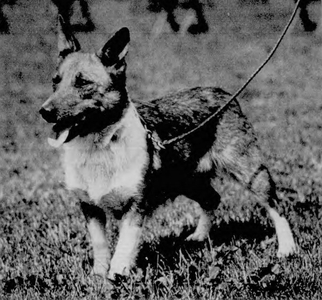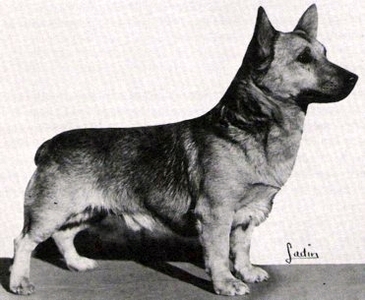The First Pembroke Corgis the USA
The history books tell us that the first Pembroke to be registered by the American Kennel Club was Little Madam (sometimes referred to as Little Madam of Merriedip).
Little Madam
This was the bitch that well known Old English Sheepdog breeder Margery Roesler (later Renner) met at Paddington Station while on a visit to a show in England, and bought on the spot for £12 from her owner Florence Lewis. She was actually bred by Nellie Bowler (Bowhit) and was by, and linebred to, the great Ch. Bowhit Pepper.
Eventually (majors were hard to come by!) Little Madam became the first American champion bitch of the breed, beaten to her title by the male UK/Am Ch (Sierra) Bowhit Pivot who had been exported to California by the Bowlers.
So she earned her place in breed history on two accounts - but did she become part of the fabric of the breed through her descendants? I must admit I hadn't been aware of any, but thanks to these catalogues a line of descent has emerged, and I suspect that she does indeed figure in the ancestry of most, possibly all, American Pems of today and of their own descendants worldwide.
In 1936 she had a litter by another of the Merriedip imports, Ch Bowhit Punter, and this produced Merriedip Early Dawn. From then on the line of descent is: Merriedip Judson, Merriedip Bonnie, Merriedip Ru-Girl, Merriedip Copper Penny, Ch Merriedip Sir Galahad. Galahad had two daughters who bred on well, Rhondda of Rover Run (behind some of the Bundocks) and Ricochet of Rover Run, whose daughter Rover Run Romance ROM was a very good brood for the Larklain kennel and is behind today's dogs via Ch L Random and L Red Flirt. So Little Madam lives on!
Simon Parsons on Facebook
First American Champion

Am. & UK Ch. Bowhit Pivot
The first Pembrokeshire Welsh corgi to win the title of American champion is Sierra Bowhit Pivot owned by E.M. Tidd of Oakland, California. Pivot was the first English champion Pembroke imported into this country, and also has the distinction of having been the first Pembroke to win the award of best of all breeds in England. This at the Carmarthen show in May, 1934. He won his American points at Golden Gate, Berkeley, Del Monte, Santa Cruz, and Oakland at the summer shows and was placed fourth in the working group at Berkeley.
Pivot is a dark red shaded with black. From the photograph sent me he looks to be a handsome fellow, low to ground, with a nice front, typical head, and wonderfully intelligent expression. In the first litter sired by him, three of the pups were born with short tails.
Pivot again combines the blood of Crymmych President and Bowhit Pepper. He is a son of President's and his dam is the result of a mating of full brother and sister sired by Pepper ex Shonky (by Shon Bach, a full brother of the breed's first champion Shan Fach and himself sired by Pepper, so Bruin and Jollity were from a grandsire to granddaughter mating - researched by Simon Parsons) .The bitch that Mr. Tidd mated to Pivot is also a descendant of Pepper.
Elizabeth H. Anderson, Bluehill, Maine
AKC Kennel Gazette
Breed notes Pembroke
Simon Parsons: I think this must be the first set of breed notes in the AKC Gazette solely for Pembrokes, written by Elizabeth Anderson of the Down East kennel.
There has been a most satisfactory entry of Pembroke Welsh corgis at the late summer shows. Ox Ridge brought out seven which attracted a great deal of attention. At this show, Mrs. Lewis Roesler's red and white bitch Little Madam made history for our breed when she was placed fourth in the working group judged by Freeman Lloyd.
In England where the breed is now firmly established and drawing big entries at the shows, they are beginning to discuss various breed characteristics, and insisting that the judges pay more attention to them than they have in the past. It is always important to emphasize certain typical things in a breed which is just beginning its show career. The eyes of a Pembroke, for instance, must be round, not oval, and the color should be hazel. The small black eye, of the slightly slanting oval eye are definitely wrong.
Also the muzzle, as stated in the standard, is "inclined to be snipy". Therefore a muzzle well filled in below the eyes, or tending to a heavy appearance, is not characteristic of our breed. The head is: "like that of a fox, and wide between the ears". The length of back is given as "medium" in the standard. Judges should not favor a short backed dog over one with a medium length of back.
The legs are definitely described as short, the correct height as 12 inches at the shoulder.
May judges have a leaning to favor short backs and straight fronts, but they should remember that the Pembroke corgi must not be judged as a terrier. He has always been a working dog, and we must try to keep his distinctive character. His general build must be such that he can dodge between the feet of the cattle as he drives. He must be able to turn quickly, run, crouch, and dodge again. He must be quick and agile, alert, keen and strong with a sleek coat and a bright, intelligent eye.
All interested in corgis are going to find considerable enjoyment and pleasure in an article on the breed by W. Lloyd Thomas that begins in this issue of the Gazette. The author lives in the corgi country and knows the breed. He has a lot to say regarding its early history.
Elizabeth H. Anderson, Bluehill, Maine
AKC Gazette. October 1935.
Breed Notes Both Breeds
Simon Parsons: This must be one of the earliest breed notes from the American Kennel Gazette, March 1935, covering both breeds.
With the great popularity of Welsh corgis in Great Britain it was obvious that it would not be long before Americans' interest would be aroused. A number have been brought over, but none had been registered or shown until Mrs. Lewis Roesler imported her Pembrokes, a dog and a bitch: Capt. William Lewis, the dog, and Little Madam, the bitch. Consequently, Mrs. Roesler has the honor to have registered and shown the first corgis in the United States.
The first showing of both types of corgis was in November at the Philadelphia show. Six corgis were benched, two Pembrokes and four Cardigans. Best of Breed went to Mrs. Roesler's Little Madam and Winners dog to Mrs. B.P. Bole's Tip.
There are two types of corgis and since the recognition of the breed the American Kennel Club has made the decision that separate classes must be given. This decision will I am sure be more satisfactory, as the two types are quite different in their points.
Welsh corgis have been called "the big little dog". Their weight is from 20 to 25 lbs., the Cardigan slightly the larger, with a longer body, and a long - natural - tail carried like a fox. The Pembroke has a shorter body and a straighter front, which with his docked tail, tends to give him a more terrier-like appearance.
Cardigans come in a variety of colors, all shades of tan, black, black and tan and merle. All should have dark eyes - not black - except the Merles where a silver eye is permitted. The colors in the Pembrokes is not so varied, tan the predominant and best liked color, but they also come in black, and black and tan.
In character and disposition each type is superlative, most affectionate and responsive, calm and obedient, and usually courteous to strangers, not noisy.
Mrs. B.P. Bole, of Cleveland, has been breeding both types of corgis, for the past three years. While she likes them both, her preference is for the Cardigans. Mrs. Bole had three Cardigan litters, and one Pembroke litter whelped this fall.
Robinscroft Blodwen, a Cardigan bitch, imported in September and bred in October to Mrs. Bole's imported dog Tip, whelped on January 3 three dogs and three bitches.
A few years before the Mohawk sailed on her most tragic trip, I had a letter from Mrs. Julian Peabody asking me to reserve one of the puppies for her, to be delivered in March, as a surprise for her children, and to take the place of an imported corgi they had lost. This shows how fascinating corgis can be. A more recent letter states that the corgi Robinscroft Buccaneer should be delivered to Pond Hollow Farm in March.
I regret that no Cardigans were seen at Westminster, but Mrs. Roesler and Miss Irving of New York showed Pembrokes.
Harriet L. Price, Robinscroft, Riverside, Conn.
American Kennel Gazette, March 1935
05.01.2021
